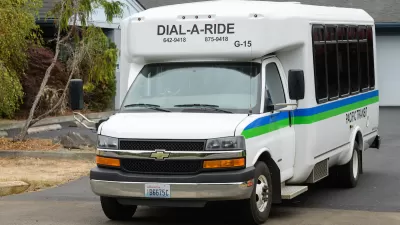On-demand microtransit is gaining popularity with transit agencies, but is it at the expense of existing service?

Transit advocates are sounding the alarm on the rapid rise of microtransit programs, which transit agencies around the country are turning to as an affordable way to supplement existing services but which some fear could undermine fixed-route services.
As Jared Brey reports in Governing, microtransit, particularly on-demand services, can help residents who aren’t otherwise well-served by transit services improve their mobility. However, “Advocates say it’s inefficient, highly expensive per rider and an opportunity cost for transit agencies that doesn’t increase ridership overall.”
Microtransit has its benefits, Brey notes, citing examples from Gwinnett County, Georgia, and Jersey City. It can vastly improve mobility options for rural residents, elderly people, and others who cannot or do not drive. But in some cases, the cost to the city is exceedingly high: programs in Los Angeles and Sacramento are costing those cities around $43 per ride.
To be fair, Brey notes, “All public transit is heavily subsidized, and many officials say it’s worth investing in options for people who don’t live near bus and train lines. But a key question is what microtransit is meant to accomplish.” For TransitCenter’s Chris Van Eyken, “Services should be judged on whether they increase overall ridership on a transit system,” and microtransit has not yet been shown to do so. The question remains whether microtransit offers “meaningful mobility at a community or city scale.”
FULL STORY: Microtransit Has Broad Appeal, Despite Clear Drawbacks

Planetizen Federal Action Tracker
A weekly monitor of how Trump’s orders and actions are impacting planners and planning in America.

Chicago’s Ghost Rails
Just beneath the surface of the modern city lie the remnants of its expansive early 20th-century streetcar system.

San Antonio and Austin are Fusing Into one Massive Megaregion
The region spanning the two central Texas cities is growing fast, posing challenges for local infrastructure and water supplies.

Since Zion's Shuttles Went Electric “The Smog is Gone”
Visitors to Zion National Park can enjoy the canyon via the nation’s first fully electric park shuttle system.

Trump Distributing DOT Safety Funds at 1/10 Rate of Biden
Funds for Safe Streets and other transportation safety and equity programs are being held up by administrative reviews and conflicts with the Trump administration’s priorities.

German Cities Subsidize Taxis for Women Amid Wave of Violence
Free or low-cost taxi rides can help women navigate cities more safely, but critics say the programs don't address the root causes of violence against women.
Urban Design for Planners 1: Software Tools
This six-course series explores essential urban design concepts using open source software and equips planners with the tools they need to participate fully in the urban design process.
Planning for Universal Design
Learn the tools for implementing Universal Design in planning regulations.
planning NEXT
Appalachian Highlands Housing Partners
Mpact (founded as Rail~Volution)
City of Camden Redevelopment Agency
City of Astoria
City of Portland
City of Laramie





























